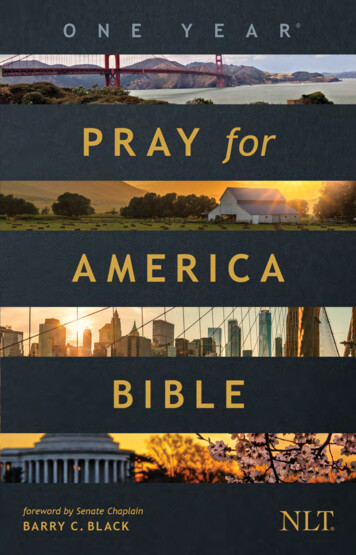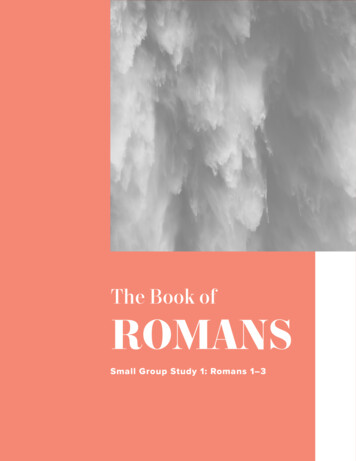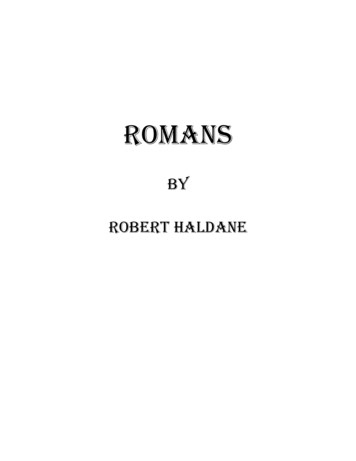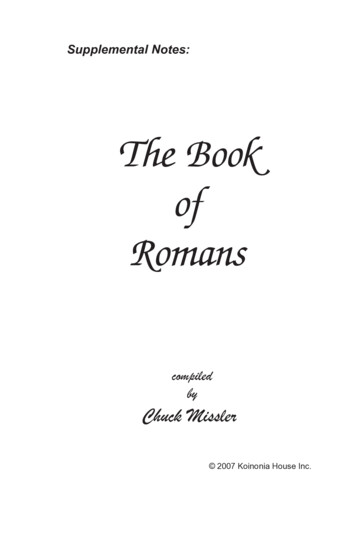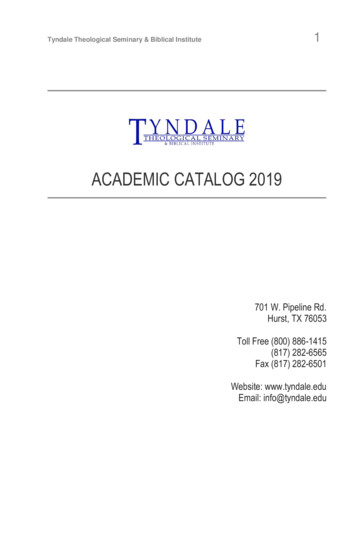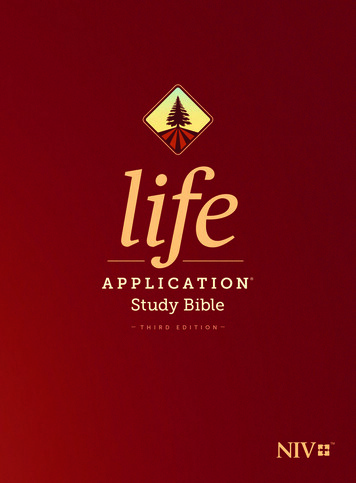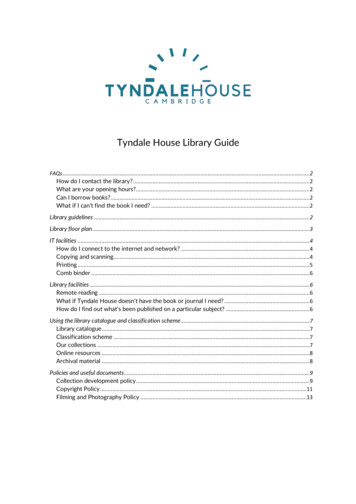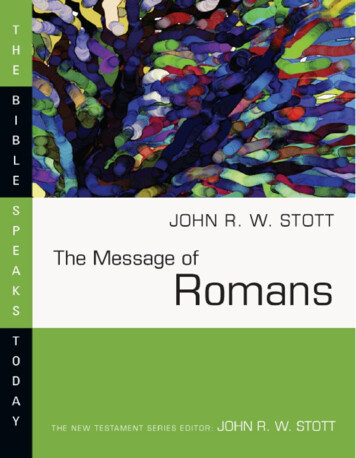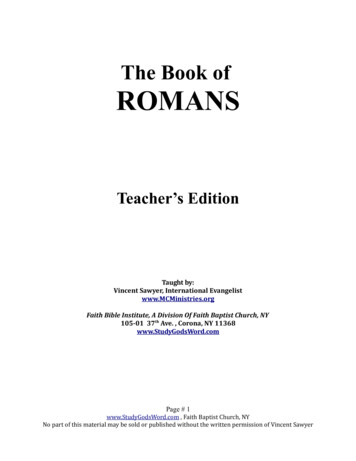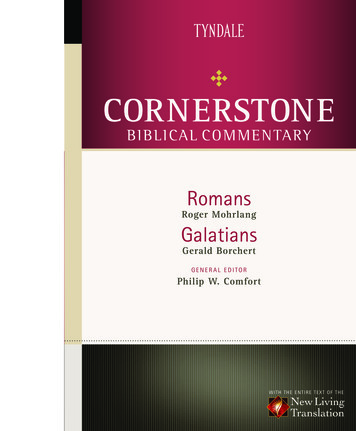
Transcription
STONEB I B L ICAL COMMENTARYRomansRoger MohrlangGalatiansGerald BorchertGENERAL EDITORPhilip W. ComfortV O L U ME14WITH THE ENTIRE TEXT OF THE
CORNERSTONEBIBLICALCOMMENTARY
General EditorPhilip W. ComfortD. Litt. et Phil., University of South Africa;Tyndale House Publishers;Coastal Carolina University.Consulting Editor, Old TestamentTremper Longman IIIPhD, Yale University;Robert H. Gundry Professor of Biblical Studies, Westmont College.Consulting Editor, New TestamentGrant OsbornePhD, University of Aberdeen;Professor of New Testament, Trinity Evangelical Divinity School.Associate EditorsJason DriesbachMA, Biblical Exegesis and Linguistics, Dallas Theological Seminary;Tyndale House Publishers.Mark R. NortonMA, Theological Studies, Wheaton Graduate School;Tyndale House Publishers.James A. SwansonMSM, Multnomah Biblical Seminary;MTh, University of South Africa;Tyndale House Publishers.
CORNERSTONEBIBLICALCOMMENTARYRomansRoger MohrlangGalatiansGerald L. BorchertGENERAL EDITORPhilip W. Comfortwith the entire text of theNEW LIVING TRANSLATIONTYNDALE HOUSE PUBLISHERS, INC. CAROL STREAM, ILLINOIS
Cornerstone Biblical Commentary, Volume 14Visit Tyndale’s exciting Web site at www.tyndale.comRomans copyright 2007 by Roger Mohrlang. All rights reserved.Galatians copyright 2007 by Gerald L. Borchert. All rights reserved.Designed by Luke Daab and Timothy R. Botts.Unless otherwise indicated, all Scripture quotations are taken from the Holy Bible, NewLiving Translation, copyright 1996, 2004. Used by permission of Tyndale HousePublishers. Inc., Carol Stream, Illinois 60188. All rights reserved.TYNDALE, New Living Translation, NLT, Tyndale’s quill logo, and the New LivingTranslation logo are registered trademarks of Tyndale House Publishers, Inc.Library of Congress Cataloging-in-Publication DataCornerstone biblical commentary.p. cm.Includes bibliographical references and index.ISBN-13: 978-0-8423-8342-4 (hc : alk. paper)ISBN-10: 0-8423-8342-5 (hc : alk. paper)1. Biblical—Commentaries. I.Printed in China12 11 10 09 08 077654321
CONTENTSContributors to Volume 14viGeneral Editor’s PrefaceviiAbbreviationsixTransliteration and Numbering SystemxiiiROMANS1GALATIANS245
CONTRIBUTORS TO V O L U M E 1 4Romans: Roger MohrlangBS, Carnegie Institute of Technology/Carnegie Mellon University;MA, Fuller Theological Seminary;DPhil, University of Oxford;Professor of Biblical Studies, Whitworth College.Galatians: Gerald L. BorchertBA, LLB, University of Alberta Law School;MDiv, Eastern Baptist Theological Seminary;ThM, PhD, Princeton Theological Seminary and Princeton University;Retired Professor of New Testament and Director of Doctoral Studies,Northern Baptist Theological Seminary.
G E N E R A LE D I T O R ’ SP R E F A C EThe Cornerstone Biblical Commentary is based on the second edition of the NewLiving Translation (2004). Nearly 100 scholars from various church backgrounds and from several countries (United States, Canada, England, andAustralia) participated in the creation of the NLT. Many of these same scholarsare contributors to this commentary series. All the commentators, whetherparticipants in the NLT or not, believe that the Bible is God’s inspired word andhave a desire to make God’s word clear and accessible to his people.This Bible commentary is the natural extension of our vision for the NewLiving Translation, which we believe is both exegetically accurate and idiomatically powerful. The NLT attempts to communicate God’s inspired word in alucid English translation of the original languages so that English readers canunderstand and appreciate the thought of the original writers. In the same way,the Cornerstone Biblical Commentary aims at helping teachers, pastors, students,and lay people understand every thought contained in the Bible. As such, thecommentary focuses first on the words of Scripture, then on the theologicaltruths of Scripture—inasmuch as the words express the truths.The commentary itself has been structured in such a way as to help readers getat the meaning of Scripture, passage by passage, through the entire Bible. EachBible book is prefaced by a substantial book introduction that gives generalhistorical background important for understanding. Then the reader is takenthrough the Bible text, passage by passage, starting with the New Living Translation text printed in full. This is followed by a section called “Notes,” wherein thecommentator helps the reader understand the Hebrew or Greek behind theEnglish of the NLT, interacts with other scholars on important interpretiveissues, and points the reader to significant textual and contextual matters. The“Notes” are followed by the “Commentary,” wherein each scholar presents alucid interpretation of the passage, giving special attention to context and majortheological themes.The commentators represent a wide spectrum of theological positions withinthe evangelical community. We believe this is good because it reflects the richvariety in Christ’s church. All the commentators uphold the authority of God’sword and believe it is essential to heed the old adage: “Wholly apply yourself tothe Scriptures and apply them wholly to you.” May this commentary help youknow the truths of Scripture, and may this knowledge help you “grow in yourknowledge of God and Jesus our Lord” (2 Pet 1:2, NLT).PHILIP W. COMFORTGENERAL EDITOR
A B B R E V I A T I O N SGENERAL ABBREVIATIONSb.BabylonianGemarabar.baraitac.circa, around,approximatelycf.confer, comparech, chs chapter, chapterscontra in contrast toDSSDead Sea Scrollsed.edition, editore.g.exempli gratia, forexampleet al.et alli, and othersfem.femininefffollowing (verses,pages)fl.flourishedGr.GreekHeb.ibid.i.e.in em, in the sameplaceid est, the samein loco, in the placecitedliterallySeptuagintMajority oretic Textno dateneuternumberNTOLOSOTp., pp.pl.Qrev.sg.t.TRv., vv.vid.viz.vol.y.New TestamentOld LatinOld SyriacOld Testamentpage, pagespluralQuelle (“Sayings”as Gospel source)revisionsingularToseftaTextus Receptusverse, versesvideur, it seemsvidelicet, namelyvolumeJerusalem GemaraABBREVIATIONS FOR BIBLE TRANSLATIONSASVCEVESVGWHCSBJBKJVNABNASBAmerican StandardVersionContemporaryEnglish VersionEnglish StandardVersionGod’s WordHolman ChristianStandard BibleJerusalem BibleKing James VersionNew American BibleNew AmericanStandard BibleNCVNEBNIVNIrVNJBNJPSNew CenturyVersionNew English BibleNew InternationalVersionNew InternationalReader’s VersionNew JerusalemBibleThe New JewishPublication ew King JamesVersionNew RevisedStandard VersionNew LivingTranslationRevised EnglishBibleRevised StandardVersionToday’s EnglishVersionThe Living BibleABBREVIATIONS FOR DICTIONARIES, LEXICONS,COLLECTIONS OF TEXTS, ORIGINAL LANGUAGE EDITIONSABD Anchor Bible Dictionary(6 vols., Freedman) [1992]ANEP The Ancient NearEast in Pictures (Pritchard)[1965]ANET Ancient Near EasternTexts Relating to the OldTestament (Pritchard)[1969]BAGD Greek-English Lexicon ofthe New Testament and OtherEarly Christian Literature,2nd ed. (Bauer, Arndt,Gingrich, Danker) [1979]BDAG Greek-English Lexicon ofthe New Testament and OtherEarly Christian Literature, 3rded. (Bauer, Danker, Arndt,Gingrich) [2000]BDB A Hebrew and EnglishLexicon of the Old Testament(Brown, Driver, Briggs)[1907]BDF A Greek Grammar of theNew Testament and OtherEarly Christian Literature(Blass, Debrunner, Funk)[1961]
ABBREVIATIONSxBHS Biblia HebraicaStuttgartensia (Elliger andRudolph) [1983]CAD Assyrian Dictionary ofthe Oriental Institute of theUniversity of Chicago [1956]COS The Context of Scripture(3 vols., Hallo and Younger)[1997–2002]DBI Dictionary of BiblicalImagery (Ryken, Wilhoit,Longman) [1998]DBT Dictionary of BiblicalTheology (2nd ed.,Leon-Dufour) [1972]DCH Dictionary of ClassicalHebrew (5 vols., D. Clines)[2000]DJD Discoveries in the JudeanDesert [1955–]DJG Dictionary of Jesusand the Gospels (Green,McKnight, Marshall) [1992]DOTP Dictionary of the OldTestament: Pentateuch.(T. Alexander, D.W. Baker)[2003]DPL Dictionary of Paul andHis Letters (Hawthorne,Martin, Reid) [1993]EDNT Exegetical Dictionary ofthe New Testament (3 vols.,H. Balz, G. Schneider. ET)[1990–1993]HALOT The Hebrew andAramaic Lexicon of the OldTestament (L. Koehler, W.Baumgartner, J. Stamm;trans. M. Richardson)[1994–1999]IBD Illustrated Bible Dictionary(3 vols., Douglas, Wiseman)[1980]IDB The Interpreter’s Dictionaryof the Bible (4 vols., Buttrick)[1962]ISBE International StandardBible Encyclopedia (4 vols.,Bromiley) [1979–1988]KBL Lexicon in VeterisTestamenti libros (Koehler,Baumgartner) [1958]LCL Loeb Classical LibraryL&N Greek-English Lexicon ofthe New Testament: Based onSemantic Domains (Louwand Nida) [1989]LSJ A Greek-English Lexicon(9th ed., Liddell, Scott,Jones) [1996]MM The Vocabulary of theGreek New Testament(Moulton and Milligan)[1930; 1997]NA26 Novum TestamentumGraece (26th ed., NestleAland) [1979]NA27 Novum TestamentumGraece (27th ed., NestleAland) [1993]NBD New Bible Dictionary(2nd ed., Douglas, Hillyer)[1982]NIDB New InternationalDictionary of the Bible(Douglas, Tenney) [1987]NIDBA New InternationalDictionary of BiblicalArchaeology (Blaiklock andHarrison) [1983]NIDNTT New InternationalDictionary of New TestamentTheology (4 vols., C. Brown)[1975–1985]NIDOTTE New InternationalDictionary of Old TestamentTheology and Exegesis (5vols., W. A. VanGemeren)[1997]PGM Papyri graecae magicae:Die griechischenZauberpapyri. (Preisendanz)[1928]PG Patrologia Graecae (J. P.Migne) [1857–1886]TBD Tyndale Bible Dictionary(Elwell, Comfort) [2001]TDNT Theological Dictionaryof the New Testament(10 vols., Kittel, Friedrich;trans. Bromiley) [1964–1976]TDOT Theological Dictionaryof the Old Testament (8 vols.,Botterweck, Ringgren; trans.Willis, Bromiley, Green)[1974–]TLNT Theological Lexicon of theNew Testament (3 vols., C.Spicq) [1994]TLOT Theological Lexicon ofthe Old Testament (3 vols.,E. Jenni) [1997]TWOT Theological Wordbookof the Old Testament (2 vols.,Harris, Archer) [1980]UBS3 United Bible Societies’Greek New Testament(3rd ed., Metzger et al.)[1975]UBS4 United Bible Societies’Greek New Testament(4th corrected ed., Metzgeret al.) [1993]WH The New Testament in theOriginal Greek (Westcott andHort) [1882]ABBREVIATIONS FOR BOOKS OF THE BIBLEOld sLeviticusNumbersDeuteronomyJoshuaJudgesRuth1 Sam2 Sam1 Kgs2 Kgs1 Chr2 ChrEzraNeh1 Samuel2 Samuel1 Kings2 Kings1 Chronicles2 ChroniclesEzraNehemiahEsthPs, PssProvEcclSongIsaJerLamEstherPsalm, PsalmsProverbsEcclesiastesSong of SongsIsaiahJeremiahLamentations
hiHebJas1 Pet2 Pet1 John2 John3 JohnJudeRevHebrewsJames1 Peter2 Peter1 John2 John3 JohnJudeRevelationNew TestamentMattMarkLukeJohnActsRom1 Cor2 CorGalMatthewMarkLukeJohnActsRomans1 Corinthians2 CorinthiansGalatiansEphPhilCol1 Thess2 Thess1 Tim2 TimTitusPhlmEphesiansPhilippiansColossians1 Thessalonians2 Thessalonians1 Timothy2 TimothyTitusPhilemonDeuterocanonicalBarAdd DanPr AzarBelSg ThreeSusBaruchAdditions to DanielPrayer of AzariahBel and the DragonSong of the ThreeChildrenSusanna1–2 EsdrAdd EsthEp JerJdt1–2 Macc3–4 Macc1–2 EsdrasAdditions to EstherEpistle of JeremiahJudith1–2 Maccabees3–4 MaccabeesPr ManPs 151SirTobWisPrayer of ManassehPsalm 151SirachTobitWisdom of SolomonMANUSCRIPTS AND LITERATURE FROM QUMRANInitial numerals followed by “Q” indicate particular caves at Qumran. For example,the notation 4Q267 indicates text 267 from cave 4 at Qumran. Further, 1QS 4:9-10indicates column 4, lines 9-10 of the Rule of the Community; and 4Q166 1 ii 2 indicatesfragment 1, column ii, line 2 of text 166 from cave 4. More examples of commonabbreviations are listed below.CD1QH1QIsaaCairo Geniza copyof the DamascusDocumentThanksgiving HymnsIsaiah copy a1QIsab1QM1QpHab1QSIsaiah copy bWar ScrollPesher HabakkukRule of ationsPsalmsTemple ScrollTargum of JobIMPORTANT NEW TESTAMENT MANUSCRIPTS(all dates given are AD; ordinal numbers refer to centuries)Significant Papyri ( Papyrus)P1 Matt 1; early 3rdP4 P64 P67 Matt 3, 5, 26;Luke 1-6; late 2ndP5 John 1, 16, 20; early 3rdP13 Heb 2-5, 10-12; early 3rdP15 P16 (probably part ofsame codex) 1 Cor 7-8,Phil 3-4; late 3rdP20 James 2-3; 3rdP22 John 15-16; mid 3rdP23 James 1; c. 200P27 Rom 8-9; 3rdP30 1 Thess 4-5; 2 Thess 1;early 3rdP32 Titus 1-2; late 2ndP37 Matt 26; late 3rdP39 John 8; first half of 3rdP40 Rom 1-4, 6, 9; 3rdP45 Gospels and Acts;early 3rdP46 Paul’s Major Epistles (lessPastorals); late 2ndP47 Rev 9-17; 3rd
ABBREVIATIONSP49 P65 Eph 4-5; 1 Thess1-2; 3rdP52 John 18; c. 125P53 Matt 26, Acts 9-10;middle 3rdP66 John; late 2ndP70 Matt 2-3, 11-12, 24; 3rdP72 1-2 Peter, Jude; c. 300xiiP74 Acts, General Epistles; 7thP75 Luke and John; c. 200P77 P103 (probably part ofP92 Eph 1, 2 Thess 1; c. 300P98 Rev 1:13-20; late 2ndP100 James 3-5; c. 300same codex) Matt 13-14, 23; P101 Matt 3-4; 3rdlate 2ndP104 Matt 21; 2ndP87 Phlm; late 2ndP106 John 1; 3rdP90 John 18-19; late 2ndP115 Rev 2-3, 5-6, 8-15; 3rdP91 Acts 2-3; 3rdSignificant Uncialsa (Sinaiticus) most of NT; 4thA (Alexandrinus) most of NT;5thB (Vaticanus) most of NT; 4thC (Ephraemi Rescriptus) mostof NT with many lacunae;5thD (Bezae) Gospels, Acts; 5thD (Claromontanus), Paul’sEpistles; 6th (different MSthan Bezae)E (Laudianus 35) Acts; 6thF (Augensis) Paul’s Epistles; 9thG (Boernerianus) Paul’sEpistles; 9thH (Coislinianus) Paul’sEpistles; 6thI (Freerianus or Washington)Paul’s Epistles; 5thL (Regius) Gospels; 8thQ (Guelferbytanus B) Luke,John; 5thP (Porphyrianus) Acts—Revelation; 9thT (Borgianus) Luke, John; 5thW (Washingtonianus or theFreer Gospels) Gospels; 5thZ (Dublinensis) Matthew; 6th037 (D; Sangallensis) Gospels;9th038 (Q; Koridethi) Gospels;9th040 (X; Zacynthius) Luke; 6th043 (F; Beratinus) Matt,Mark; 6th044 (Y; Athous Laurae)Gospels, Acts, Paul’sEpistles; 9th048 Acts, Paul’s Epistles,General Epistles; 5th0171 Matt 10, Luke 22;c. 3000189 Acts 5; c. 200Significant Minuscules1 Gospels, Acts, Paul’s Epistles;12th33 All NT except Rev; 9th81 Acts, Paul’s Epistles,General Epistles; 1044565 Gospels; 9th700 Gospels; 11th1424 (or Family 1424—agroup of 29 manuscriptssharing nearly the sametext) most of NT; 9th-10th1739 Acts, Paul’s Epistles; 10th2053 Rev; 13th2344 Rev; 11thf 1 (a family of manuscriptsincluding 1, 118, 131, 209)Gospels; 12th-14thf 13 (a family of manuscriptsincluding 13, 69, 124, 174,230, 346, 543, 788, 826,828, 983, 1689, 1709—known as the Ferrar group)Gospels; 11th-15thSignificant Ancient VersionsSYRIAC (SYR)syr c (Syriac Curetonian)Gospels; 5thsyrs (Syriac Sinaiticus)Gospels; 4thsyrh (Syriac Harklensis) EntireNT; 616OLD LATIN (IT)COPTIC (COP)it a (Vercellenis) Gospels; 4thit b (Veronensis) Gospels; 5thitd (Cantabrigiensis—the Latintext of Bezae) Gospels, Acts,3 John; 5theit (Palantinus) Gospels; 5thitk (Bobiensis) Matthew, Mark;c. 400copbo (Boharic—north Egypt)copfay (Fayyumic—central Egypt)copsa (Sahidic—southern Egypt)OTHER VERSIONSarm (Armenian)eth (Ethiopic)geo (Georgian)
TRANSLITERATION ANDNUMBERING SYSTEMNote: For words and roots from non-biblical languages (e.g., Arabic, Ugaritic),only approximate transliterations are given.HEBREW/ARAMAICConsonantsaalephB, bbethG, ggimelD, ddalethhhewwawzzayinjhethftethyyodhK, k, û kaphllamedh ’ b g d h w z kh t y k lm, µmemn, nunssamekh[ayinP, p, ¹ pex, ÅtsadheqqophrreshvshincsinT, ttaw m n s ‘ p ts q r sh s t, th(spirant)Vowels¾j¾;h;,eyeiiyipatakhfurtive patakhqametsfinal qamets hesegoltseretsere yodshort hireqlong hireqhireq yod a a a ah e e e i i i]y¾qamets khatufholemfull holemshort qibbutslong qibbutsshureqkhatef patakhkhatef qametsvocalic shewapatakh yodhezhqiepsilonzetaetathetaiota;o/uuW}Õ o o o u u u a o e aGreekabgalphabetagammaddelta a b g, n (beforeg, k, x, c) d e z e th i
NUMBERING SYSTEMklmnxoprs, kappalamdamunuksiomicronpirhosigmaxiv k l m n x o p r (ª rh) stufcywJtauupsilonphichipsiomegaroughbreathingmark t u ph ch ps o h (withvowel ordiphthong)THE TYNDALE-STRONG’S NUMBERING SYSTEMThe Cornerstone Biblical Commentary series uses a word-study numbering systemto give both newer and more advanced Bible students alike quicker, more convenientaccess to helpful original-language tools (e.g., concordances, lexicons, and theologicaldictionaries). Those who are unfamiliar with the ancient Hebrew, Aramaic, and Greekalphabets can quickly find information on a given word by looking up the appropriateindex number. Advanced students will find the system helpful because it allows themto quickly find the lexical form of obscure conjugations and inflections.There are two main numbering systems used for biblical words today. The onefamiliar to most people is the Strong’s numbering system (made popular by theStrong’s Exhaustive Concordance to the Bible). Although the original Strong’s system isstill quite useful, the most up-to-date research has shed new light on the biblicallanguages and allows for more precision than is found in the original Strong’s system.The Cornerstone Biblical Commentary series, therefore, features a newly revisedversion of the Strong’s system, the Tyndale-Strong’s numbering system. The TyndaleStrong’s system brings together the familiarity of the Strong’s system and the best ofmodern scholarship. In most cases, the original Strong’s numbers are preserved. Inplaces where new research dictates, new or related numbers have been added.1The second major numbering system today is the Goodrick-Kohlenberger systemused in a number of study tools published by Zondervan. In order to give studentsbroad access to a number of helpful tools, the Commentary provides index numbersfor the Zondervan system as well.The different index systems are designated as follows:TG Tyndale-Strong’s Greek numberZG Zondervan Greek numberTH Tyndale-Strong’s Hebrew numberZH Zondervan Hebrew numberTA Tyndale-Strong’s Aramaic numberZA Zondervan Aramaic numberSo in the example, “love” agape [TG26, ZG27], the first number is the one to use withGreek tools keyed to the Tyndale-Strong’s system, and the second applies to tools thatuse the Zondervan system.1. Generally, one may simply use the original four-digit Strong’s number to identify words in tools using Strong’s system. If aTyndale-Strong’s number is followed by a capital letter (e.g., TG1692A), it generally indicates an added subdivision of meaningfor the given term. Whenever a Tyndale-Strong’s number has a number following a decimal point (e.g., TG2013.1), it reflects aninstance where new research has yielded a separate, new classification of use for a biblical word. Forthcoming tools from TyndaleHouse Publishers will include these entries, which were not part of the original Strong’s system.
RomansROGER MOHRLANG
INTRODUCTION TORomansPAUL’S LETTER TO THE ROMANS is one of the most significant writings ever to comefrom the hand of a Christian. Theologically, it is certainly the most important of allof Paul’s letters, and many would say it is the single most important document inthe entire New Testament—indeed, “arguably the single most important work ofChristian theology ever written” (Dunn 1993:838). It is the most fully developedtheological statement we have from the earliest Christians. Of all the New Testament writings, it is Romans that gives us the most comprehensive exposition andanalysis of the Christian gospel, the Good News of salvation in Jesus Christ.Because of this, Romans has been extremely influential in the history of theChristian church and, indeed, in the history of the western world. It was instrumental in the formulation of the early Christian creeds, and it shaped the lives andthinking of such key figures as Augustine (reflected in his understanding of humansinfulness and of grace), Luther (justification by faith), Calvin (God’s sovereigntyand predestination), Wesley (the transforming work of the Holy Spirit), and Barth(God’s sovereign revelation of grace). It played a key role in the rise of theProtestant Reformation and, more than any other single work, has shaped the theology of the modern-day evangelical movement (reflected, for example, in thepreaching of Billy Graham and in Campus Crusade for Christ’s “Four SpiritualLaws”). Luther thought the book to be so important that “every Christian shouldknow it word for word, by heart, [and] occupy himself with it every day, as the dailybread of the soul. It can never be read or pondered too much,” he wrote, “and themore it is dealt with the more precious it becomes, and the better it tastes” (Luther1954:xi).Without question, of all the letters of Paul, Romans is the weightiest and mostsignificant theologically and comes closest to being a carefully constructed theological exposition. Here, in well-organized form, Paul gives us all the central elementsof his understanding of the Christian faith: God’s saving work in Christ, the doctrine of justification by faith, the claims of Christ as Lord, the life-transformingwork of the Holy Spirit, the confident expectation of sharing in God’s glory, andmuch more. Here we have the quintessence of Paul’s theological thought. A goodgrasp of Romans is crucial, then, if we are to understand Paul.But understanding Romans is no easy task; it is difficult to know how to put allthe pieces together. (The title of John A. T. Robinson’s book, Wrestling with Romans,is apropos.) Of all Paul’s writings, this one, more than any other, has challenged—
ROMANS4and continues to challenge—the intellectual powers of interpreters. The seeminginconsistencies and enigmatic logic give rise to many questions and make Romansthe most perplexing of Paul’s letters. There may well be more written about Romansthan about any other book of the New Testament. (For an extensive list of commentaries up to 1973, see Cranfield 1980:xiii-xviii.) But the book of Romans is wellworth the struggle.Here, then, is the greatest of all Paul’s letters, a letter that many Christians believeis the single most important writing in the entire New Testament—indeed, perhapsthe most significant Christian document in the whole of human history. Here Godin his mercy has given us a window into the single most important thing in life, oursalvation, with all of its life-changing ramifications. A good grasp of Romans isessential not only for our understanding of Paul but for our understanding of theearly Christians’ perception of Jesus and his significance, and of the message thatlies at the very heart of the New Testament.AUTHORThere is no question that Paul is the author of the Letter to the Romans. Thoughdoubts are frequently raised about the authenticity of several of the other writingsbearing Paul’s name (esp. 1 and 2 Timothy and Titus—but also Ephesians, Colossians, and 2 Thessalonians), there is almost universal acknowledgment among scholars that Paul is the author of Romans.1 The letter is included in every early list of Paul’sletters, and its language, style, and theology are all characteristically Pauline.Though Paul is the author, it is clear that he was not the actual writer per se, inasmuch as Tertius is named as the writer of the epistle (16:22). In keeping withcommon practice in the Roman world, Paul used the services of Tertius as a secretary (or amanuensis) to write the letter for him. How much of this letter, then,actually came from Paul? Did Paul dictate the letter word by word? Or did Tertiustake down Paul’s thoughts in a form of shorthand and then later write them out inhis own words? Or did Paul simply give Tertius a sketch of what he wanted to say,allowing him a free hand in composing a letter that expressed those ideas? Inother words, how much freedom did the secretary have in the actual writing?2It is impossible to know exactly what Paul communicated to Tertius. But given(1) the importance of the subject matter—the eternal Good News, (2) the carefuland extensive way the complex case is argued, (3) the seriousness with which Paultook his apostolic calling and his readers’ response to it, and (4) his concern that henot be misinterpreted, it seems likely that Paul would have had a strong interest inmaking sure that the final wording expressed his thoughts accurately. So, howeverhe used his secretary, we may be reasonably confident that the letter as it stands is anaccurate expression of Paul’s thought and that he would have been careful to ensurethat. With respect to Paul’s direct involvement in the whole writing process,Cranfield observes, “In view of the inherent improbability that someone capable ofthe highly original, closely articulated and also extremely difficult thought whichhas gone into the Epistle to the Romans would ever have voluntarily entrusted the
5ROMANSexpression of it to another person, we conclude that Tertius either wrote the epistlein longhand directly from Paul’s dictation or else took it down first in shorthand,and that we may be confident that we have in the text which Tertius wrote thethought of Paul for all intents and purposes expressed as Paul himself expressed it”(1980:2-5).There is some question as to whether Paul wrote the final invocation of grace(16:20, 24), the final doxology (16:25-27), and the final long list of greetings(16:3-23); see “Canonicity and Textual History” below.DATE AND OCCASION OF WRITINGThe Letter to the Romans was written near the end of Paul’s third major missiontrip (described in Acts 18:23–20:38), when he was about to set off for Jerusalemwith money he had been collecting for the poverty-stricken Christians in Judea(15:25-26). (It is possible that he thought this gift would help to allay Jewish suspicions about him and his work among Gentiles and serve to bring the two branchesof the church closer together [Käsemann 1980:403ff; Dunn 1988a:xlii]). The letterseems to have been written during the three months Paul spent in southern Greece(the Roman province of Achaia) before leaving for Jerusalem (Acts 20:2-3). Mostprobably it was written from Corinth, the capital and home of the key church ofthe province. Hints of this are found in the references to Phoebe of Cenchrea, Corinth’s eastern port (16:1), and to Gaius and Erastus, who may have lived inCorinth (16:23; cf. Acts 19:22; 1 Cor 1:14; 2 Tim 4:20). Thus, the letter was mostprobably written during the winter or early spring of AD 55–56 or 56–57(Cranfield 1980:12-16; Dunn 1988a:xliii-xliv).After a decade of productive evangelism and church planting in the Aegean area(in the major towns of the Roman provinces of Galatia, Asia, Macedonia, andAchaia especially), Paul felt his missionary work in the northeastern end of theMediterranean was over, at least for a time. Following his trip to Jerusalem heintended to head west—all the way to Spain, the oldest Roman province in theWest, which, at that time, was beginning to produce some of the great men ofthe Roman Empire (Seneca, Trajan, and Hadrian all had Spanish ancestry). On theway, he hoped to stop for a time in Rome—a visit he had long anticipated—to seethe Christians and do evangelistic work there before being assisted by them on hisway to the western end of the Mediterranean (1:13-15; 15:23-29). This letter, senton ahead, served to notify the Christians in Rome of his plans.Why did Paul choose this particular occasion to spell out in such detail hisunderstanding of the Good News and its relevance to both Jews and Gentiles? Werethere tensions in the church between the two groups, or conflicting understandingsof salvation or the role of the Jewish law? Or was Paul attempting to head off suchproblems before they erupted? (By this time he was certainly aware of the strengthof Jewish-Christian sentiment against his seemingly law-free gospel, but how muchthis sentiment had surfaced in the church in Rome is not clear.) Was there confusion over the role of Jews and Gentiles in God’s overall plan? Was there opposition
ROMANS6to Paul himself? In other words, was Paul addressing specific problems in theRoman church, or was he simply hoping to lay a solid theological foundation for animportant young and growing church whose establishment and development hehad not personally overseen?The answers are not entirely clear, and scholarly opinions vary widely. In reality,Paul may well have been concerned with a number of issues such as tensions or disagreements in the church, potential or real opposition to himself and his message, theneed to lay a foundation for his evangelistic work, and the role of Rome in his futuremissionary work in the western Mediterranean (Cranfield 1981:814-823; Fitzmyer1993:68-80; Dunn 1988a:lv-lviii; cf. Moo 1996:20-21).3 Nonetheless, his primaryconcern was clearly to expound in some depth, against the background of the Jewishlaw, the Good News itself—and to show its broader implications for both Jews andGentiles. (Note his repeated emphasis that the Good News is for everyone who believes: 1:16; 3:29-30; 4:9-17; 9:24-26; 10:11-13; 11:11-32; 15:7-12.) This is whatdominates his thought in Romans. The other issues—for example, the matter of the relationship between the two groups, which some take to be the central concern of theletter (so Kaylor 1988:18ff)—are clearly secondary. Such issues may well have helpedto shape what Paul wrote and emphasized (cf. chs 9–11, 14–15), but they are not theprimary issues he deals with in this letter. Although it is popular today to emphasizethe importance of understanding the letter in light of the specific problems facingthe church or the author (cf. Dunn 1988a:lvii; Wedderburn 1988:140-142; Moo1996:16-22), a careful reading of the letter makes it clear that the dominant focus isnot on the problems of the church or the author per se but on the all-absorbingcontent of the Good News itself (so Cranfield
Robert H. Gundry Professor of Biblical Studies, Westmont College. Consulting Editor, New Testament Grant Osborne PhD, University of Aberdeen; Professor of New Testament, Trinity Evangelical Divinity School. Associate Editors Jason Driesbach MA, Biblical Exegesis and Linguistics, Dallas Theological Seminary; Tyndale House Publishers. Mark R. Norton

